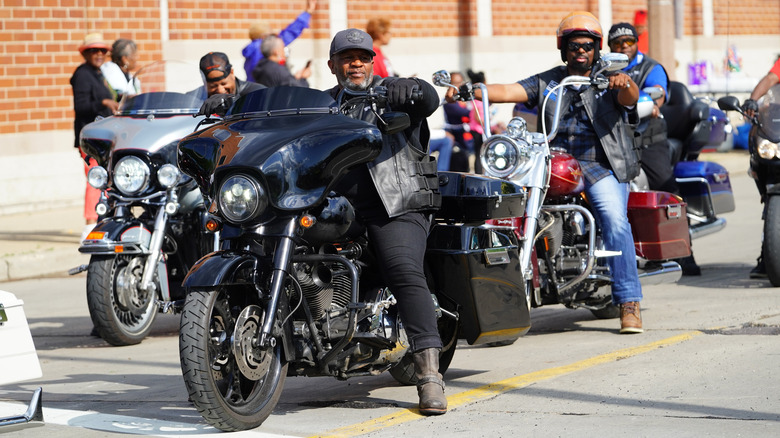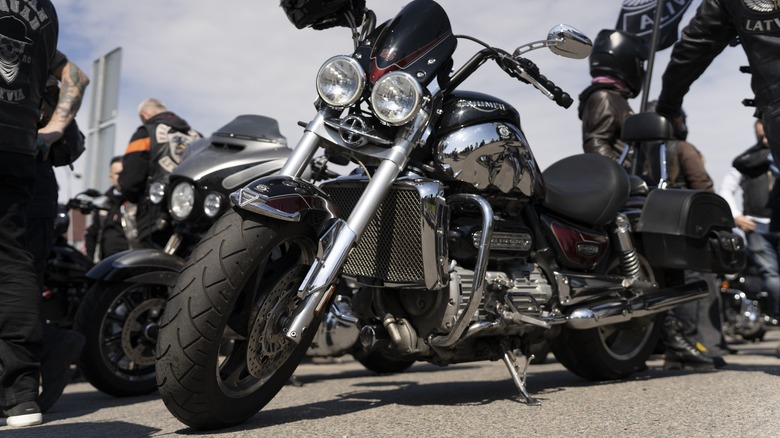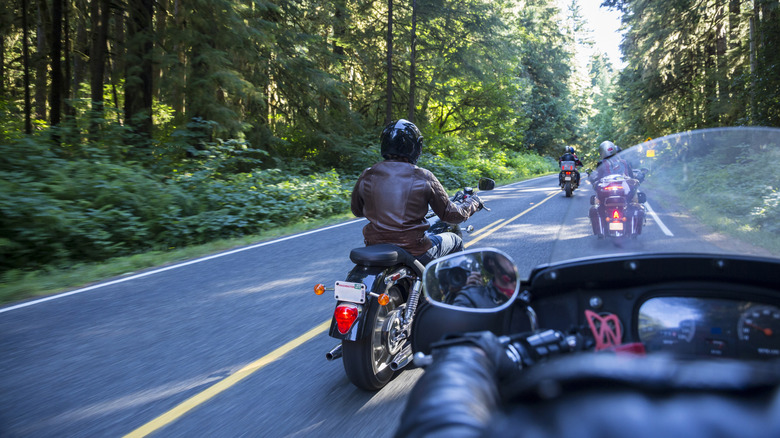Outlaw Motorcycle Gangs Vs. Motorcycle Clubs: What's The Difference?
After World War II, veterans had a difficult time adjusting to civilian life, but many of them found a sense of purpose, camaraderie, and order with other veterans. Between their severance and a booming postwar economy, it was easy for them to buy motorcycles, giving them something to coalesce around. Little did anyone know it at the time, but a new subculture was in the making. The image you, your neighbor, and just about everyone else envisions for a motorcycle gang member emerged in 1947. The American Motorcyclist Association held a race in Hollister, California, that hundreds of motorcycle enthusiasts attended, and allegedly, they turned it into a night of drunken debauchery.
Time magazine documented the depravity, but it was an photograph of biker Eddie Davenport sitting on a bike with a beer in his hand and empty bottles laying at his feet that many remember of July 4, 1947. While bikers who were present for the event argued that it wasn't as bad as Time made it out to be, the biker reputation was already solidified and it became the real-life event that inspired Marlon Brando's movie "The Wild One."
The so-called Hollister riots forced the American Motorcycle Association to claim that 99% of its members were law-abiding citizens, while 1% weren't, according to Vox. This cemented the biker image as well as split the subculture into two groups. Bikers were either law-abiding and rode with other law-abiding motorcycle enthusiasts or they were a one-percenter and joined up with one of the emerging outlaw motorcycle gangs (OMGs).
Outlaw motorcycle gangs are like any other street gang
As of 2021, the United States Department of Justice estimated that there were roughly 300 active OMGs. That isn't a small number when you consider the Hells Angels had 217 chapters across 27 countries with around 3,000 members in 2002. With numbers like that, 1% starts to feel like a significantly large number. The Hells Angels eventually became the biggest motorcycle club in California as well as one of the "Big Four" OMGs in the U.S. Bikers in an outlaw gang are known to commit petty crimes like getting in bar fights or running red lights. They probably don't bat an eye when they do break one of those laws, but that's because committing more serious federal crimes can desensitize you to anything else.
Many of the 300 OMGs in the U.S. get involved in a plethora of crimes, including money laundering, murder, fraud, theft, counterfeiting, extortion, prostitution, trafficking illegal weapons, and trafficking narcotics. The violence these gangs inflict on a regular basis can happen without notice. In October 2024, 16 members of Hells Angels were arrested in Fayetteville, North Carolina, for attacking a member of the rival gang, the Pagans.
This attack happened based on a "green light" Hells Angels members have, giving a directive to attack any member of the Pagans on sight. Many OMGs are proud to be OMGs and will often wear patches that label them as such.
Motorcycle clubs are more akin to a social club
While it's possible for a motorcycle gang member to avoid partaking in any of their gang's illegal activity and focus on the riding with friends aspect of it instead, the majority of law-abiding bikers join a regular motorcycle club (MC). MCs are a completely different story. While they may fit into the biker subculture image of jeans, leather vests, tattoos, long beards, and intimidating demeanors, they set themselves apart from the delinquents by giving back to their community. They do so by staying within the bounds of the law and loathe comparisons to OMGs. They instead prefer to simply have a good time and ride around on their motorcycles with their friends.
Probably the most well-known and largest MC in the world is the American Motorcycle Association (AMA). Over 1 million bikers wear its patch and take advantage of the many races and rallies it holds. The Boozefighters, the group that received the bulk of the blame for the Hollister debacle, is an MC known for its charity events. Actor Robert Patrick, known for "Terminator 2: Judgment Day" and "Peacemaker" is a notable Boozefighter member, traveling the country with the club to raise money for vets, children, and underprivileged groups.
Some MCs recruit specific demographics, such as law enforcement, veterans, or Harley owners. While others simply recruit anyone who shares their passion for motorcycles, but just about every MC has criteria members need to meet before joining.


